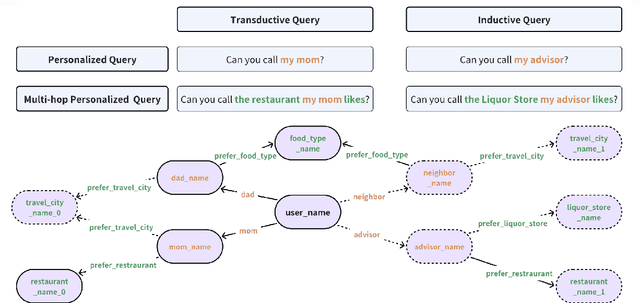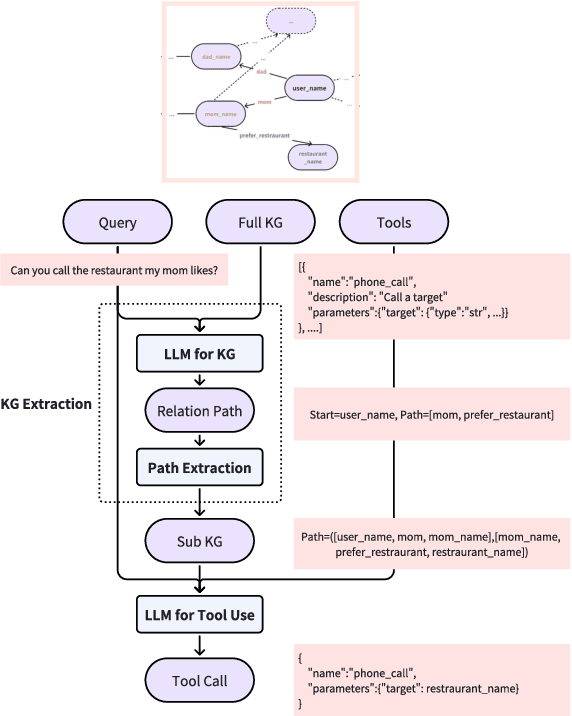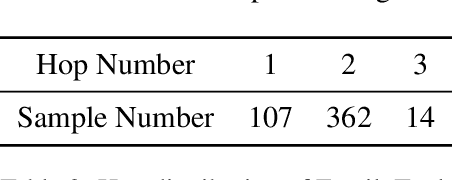Shuo Chen
OmniEAR: Benchmarking Agent Reasoning in Embodied Tasks
Aug 07, 2025Abstract:Large language models excel at abstract reasoning but their capacity for embodied agent reasoning remains largely unexplored. We present OmniEAR, a comprehensive framework for evaluating how language models reason about physical interactions, tool usage, and multi-agent coordination in embodied tasks. Unlike existing benchmarks that provide predefined tool sets or explicit collaboration directives, OmniEAR requires agents to dynamically acquire capabilities and autonomously determine coordination strategies based on task demands. Through text-based environment representation, we model continuous physical properties and complex spatial relationships across 1,500 scenarios spanning household and industrial domains. Our systematic evaluation reveals severe performance degradation when models must reason from constraints: while achieving 85-96% success with explicit instructions, performance drops to 56-85% for tool reasoning and 63-85% for implicit collaboration, with compound tasks showing over 50% failure rates. Surprisingly, complete environmental information degrades coordination performance, indicating models cannot filter task-relevant constraints. Fine-tuning improves single-agent tasks dramatically (0.6% to 76.3%) but yields minimal multi-agent gains (1.5% to 5.5%), exposing fundamental architectural limitations. These findings demonstrate that embodied reasoning poses fundamentally different challenges than current models can address, establishing OmniEAR as a rigorous benchmark for evaluating and advancing embodied AI systems. Our code and data are included in the supplementary materials and will be open-sourced upon acceptance.
DreamComposer++: Empowering Diffusion Models with Multi-View Conditions for 3D Content Generation
Jul 03, 2025Abstract:Recent advancements in leveraging pre-trained 2D diffusion models achieve the generation of high-quality novel views from a single in-the-wild image. However, existing works face challenges in producing controllable novel views due to the lack of information from multiple views. In this paper, we present DreamComposer++, a flexible and scalable framework designed to improve current view-aware diffusion models by incorporating multi-view conditions. Specifically, DreamComposer++ utilizes a view-aware 3D lifting module to extract 3D representations of an object from various views. These representations are then aggregated and rendered into the latent features of target view through the multi-view feature fusion module. Finally, the obtained features of target view are integrated into pre-trained image or video diffusion models for novel view synthesis. Experimental results demonstrate that DreamComposer++ seamlessly integrates with cutting-edge view-aware diffusion models and enhances their abilities to generate controllable novel views from multi-view conditions. This advancement facilitates controllable 3D object reconstruction and enables a wide range of applications.
BiTrajDiff: Bidirectional Trajectory Generation with Diffusion Models for Offline Reinforcement Learning
Jun 06, 2025Abstract:Recent advances in offline Reinforcement Learning (RL) have proven that effective policy learning can benefit from imposing conservative constraints on pre-collected datasets. However, such static datasets often exhibit distribution bias, resulting in limited generalizability. To address this limitation, a straightforward solution is data augmentation (DA), which leverages generative models to enrich data distribution. Despite the promising results, current DA techniques focus solely on reconstructing future trajectories from given states, while ignoring the exploration of history transitions that reach them. This single-direction paradigm inevitably hinders the discovery of diverse behavior patterns, especially those leading to critical states that may have yielded high-reward outcomes. In this work, we introduce Bidirectional Trajectory Diffusion (BiTrajDiff), a novel DA framework for offline RL that models both future and history trajectories from any intermediate states. Specifically, we decompose the trajectory generation task into two independent yet complementary diffusion processes: one generating forward trajectories to predict future dynamics, and the other generating backward trajectories to trace essential history transitions.BiTrajDiff can efficiently leverage critical states as anchors to expand into potentially valuable yet underexplored regions of the state space, thereby facilitating dataset diversity. Extensive experiments on the D4RL benchmark suite demonstrate that BiTrajDiff achieves superior performance compared to other advanced DA methods across various offline RL backbones.
X-MethaneWet: A Cross-scale Global Wetland Methane Emission Benchmark Dataset for Advancing Science Discovery with AI
May 23, 2025Abstract:Methane (CH$_4$) is the second most powerful greenhouse gas after carbon dioxide and plays a crucial role in climate change due to its high global warming potential. Accurately modeling CH$_4$ fluxes across the globe and at fine temporal scales is essential for understanding its spatial and temporal variability and developing effective mitigation strategies. In this work, we introduce the first-of-its-kind cross-scale global wetland methane benchmark dataset (X-MethaneWet), which synthesizes physics-based model simulation data from TEM-MDM and the real-world observation data from FLUXNET-CH$_4$. This dataset can offer opportunities for improving global wetland CH$_4$ modeling and science discovery with new AI algorithms. To set up AI model baselines for methane flux prediction, we evaluate the performance of various sequential deep learning models on X-MethaneWet. Furthermore, we explore four different transfer learning techniques to leverage simulated data from TEM-MDM to improve the generalization of deep learning models on real-world FLUXNET-CH$_4$ observations. Our extensive experiments demonstrate the effectiveness of these approaches, highlighting their potential for advancing methane emission modeling and contributing to the development of more accurate and scalable AI-driven climate models.
OpenSeg-R: Improving Open-Vocabulary Segmentation via Step-by-Step Visual Reasoning
May 22, 2025Abstract:Open-Vocabulary Segmentation (OVS) has drawn increasing attention for its capacity to generalize segmentation beyond predefined categories. However, existing methods typically predict segmentation masks with simple forward inference, lacking explicit reasoning and interpretability. This makes it challenging for OVS model to distinguish similar categories in open-world settings due to the lack of contextual understanding and discriminative visual cues. To address this limitation, we propose a step-by-step visual reasoning framework for open-vocabulary segmentation, named OpenSeg-R. The proposed OpenSeg-R leverages Large Multimodal Models (LMMs) to perform hierarchical visual reasoning before segmentation. Specifically, we generate both generic and image-specific reasoning for each image, forming structured triplets that explain the visual reason for objects in a coarse-to-fine manner. Based on these reasoning steps, we can compose detailed description prompts, and feed them to the segmentor to produce more accurate segmentation masks. To the best of our knowledge, OpenSeg-R is the first framework to introduce explicit step-by-step visual reasoning into OVS. Experimental results demonstrate that OpenSeg-R significantly outperforms state-of-the-art methods on open-vocabulary semantic segmentation across five benchmark datasets. Moreover, it achieves consistent gains across all metrics on open-vocabulary panoptic segmentation. Qualitative results further highlight the effectiveness of our reasoning-guided framework in improving both segmentation precision and interpretability. Our code is publicly available at https://github.com/Hanzy1996/OpenSeg-R.
Selftok: Discrete Visual Tokens of Autoregression, by Diffusion, and for Reasoning
May 18, 2025Abstract:We completely discard the conventional spatial prior in image representation and introduce a novel discrete visual tokenizer: Self-consistency Tokenizer (Selftok). At its design core, we compose an autoregressive (AR) prior -- mirroring the causal structure of language -- into visual tokens by using the reverse diffusion process of image generation. The AR property makes Selftok fundamentally distinct from traditional spatial tokens in the following two key ways: - Selftok offers an elegant and minimalist approach to unify diffusion and AR for vision-language models (VLMs): By representing images with Selftok tokens, we can train a VLM using a purely discrete autoregressive architecture -- like that in LLMs -- without requiring additional modules or training objectives. - We theoretically show that the AR prior satisfies the Bellman equation, whereas the spatial prior does not. Therefore, Selftok supports reinforcement learning (RL) for visual generation with effectiveness comparable to that achieved in LLMs. Besides the AR property, Selftok is also a SoTA tokenizer that achieves a favorable trade-off between high-quality reconstruction and compression rate. We use Selftok to build a pure AR VLM for both visual comprehension and generation tasks. Impressively, without using any text-image training pairs, a simple policy gradient RL working in the visual tokens can significantly boost the visual generation benchmark, surpassing all the existing models by a large margin. Therefore, we believe that Selftok effectively addresses the long-standing challenge that visual tokens cannot support effective RL. When combined with the well-established strengths of RL in LLMs, this brings us one step closer to realizing a truly multimodal LLM. Project Page: https://selftok-team.github.io/report/.
Discrete Visual Tokens of Autoregression, by Diffusion, and for Reasoning
May 12, 2025Abstract:We completely discard the conventional spatial prior in image representation and introduce a novel discrete visual tokenizer: Self-consistency Tokenizer (Selftok). At its design core, we compose an autoregressive (AR) prior -- mirroring the causal structure of language -- into visual tokens by using the reverse diffusion process of image generation. The AR property makes Selftok fundamentally distinct from traditional spatial tokens in the following two key ways: - Selftok offers an elegant and minimalist approach to unify diffusion and AR for vision-language models (VLMs): By representing images with Selftok tokens, we can train a VLM using a purely discrete autoregressive architecture -- like that in LLMs -- without requiring additional modules or training objectives. - We theoretically show that the AR prior satisfies the Bellman equation, whereas the spatial prior does not. Therefore, Selftok supports reinforcement learning (RL) for visual generation with effectiveness comparable to that achieved in LLMs. Besides the AR property, Selftok is also a SoTA tokenizer that achieves a favorable trade-off between high-quality reconstruction and compression rate. We use Selftok to build a pure AR VLM for both visual comprehension and generation tasks. Impressively, without using any text-image training pairs, a simple policy gradient RL working in the visual tokens can significantly boost the visual generation benchmark, surpassing all the existing models by a large margin. Therefore, we believe that Selftok effectively addresses the long-standing challenge that visual tokens cannot support effective RL. When combined with the well-established strengths of RL in LLMs, this brings us one step closer to realizing a truly multimodal LLM. Project Page: https://selftok-team.github.io/report/.
CoProSketch: Controllable and Progressive Sketch Generation with Diffusion Model
Apr 11, 2025Abstract:Sketches serve as fundamental blueprints in artistic creation because sketch editing is easier and more intuitive than pixel-level RGB image editing for painting artists, yet sketch generation remains unexplored despite advancements in generative models. We propose a novel framework CoProSketch, providing prominent controllability and details for sketch generation with diffusion models. A straightforward method is fine-tuning a pretrained image generation diffusion model with binarized sketch images. However, we find that the diffusion models fail to generate clear binary images, which makes the produced sketches chaotic. We thus propose to represent the sketches by unsigned distance field (UDF), which is continuous and can be easily decoded to sketches through a lightweight network. With CoProSketch, users generate a rough sketch from a bounding box and a text prompt. The rough sketch can be manually edited and fed back into the model for iterative refinement and will be decoded to a detailed sketch as the final result. Additionally, we curate the first large-scale text-sketch paired dataset as the training data. Experiments demonstrate superior semantic consistency and controllability over baselines, offering a practical solution for integrating user feedback into generative workflows.
FamilyTool: A Multi-hop Personalized Tool Use Benchmark
Apr 09, 2025



Abstract:The integration of tool learning with Large Language Models (LLMs) has expanded their capabilities in handling complex tasks by leveraging external tools. However, existing benchmarks for tool learning inadequately address critical real-world personalized scenarios, particularly those requiring multi-hop reasoning and inductive knowledge adaptation in dynamic environments. To bridge this gap, we introduce FamilyTool, a novel benchmark grounded in a family-based knowledge graph (KG) that simulates personalized, multi-hop tool use scenarios. FamilyTool challenges LLMs with queries spanning 1 to 3 relational hops (e.g., inferring familial connections and preferences) and incorporates an inductive KG setting where models must adapt to unseen user preferences and relationships without re-training, a common limitation in prior approaches that compromises generalization. We further propose KGETool: a simple KG-augmented evaluation pipeline to systematically assess LLMs' tool use ability in these settings. Experiments reveal significant performance gaps in state-of-the-art LLMs, with accuracy dropping sharply as hop complexity increases and inductive scenarios exposing severe generalization deficits. These findings underscore the limitations of current LLMs in handling personalized, evolving real-world contexts and highlight the urgent need for advancements in tool-learning frameworks. FamilyTool serves as a critical resource for evaluating and advancing LLM agents' reasoning, adaptability, and scalability in complex, dynamic environments. Code and dataset are available at Github.
Supposedly Equivalent Facts That Aren't? Entity Frequency in Pre-training Induces Asymmetry in LLMs
Mar 28, 2025Abstract:Understanding and mitigating hallucinations in Large Language Models (LLMs) is crucial for ensuring reliable content generation. While previous research has primarily focused on "when" LLMs hallucinate, our work explains "why" and directly links model behaviour to the pre-training data that forms their prior knowledge. Specifically, we demonstrate that an asymmetry exists in the recognition of logically equivalent facts, which can be attributed to frequency discrepancies of entities appearing as subjects versus objects. Given that most pre-training datasets are inaccessible, we leverage the fully open-source OLMo series by indexing its Dolma dataset to estimate entity frequencies. Using relational facts (represented as triples) from Wikidata5M, we construct probing datasets to isolate this effect. Our experiments reveal that facts with a high-frequency subject and a low-frequency object are better recognised than their inverse, despite their logical equivalence. The pattern reverses in low-to-high frequency settings, and no statistically significant asymmetry emerges when both entities are high-frequency. These findings highlight the influential role of pre-training data in shaping model predictions and provide insights for inferring the characteristics of pre-training data in closed or partially closed LLMs.
 Add to Chrome
Add to Chrome Add to Firefox
Add to Firefox Add to Edge
Add to Edge